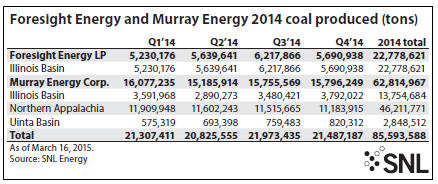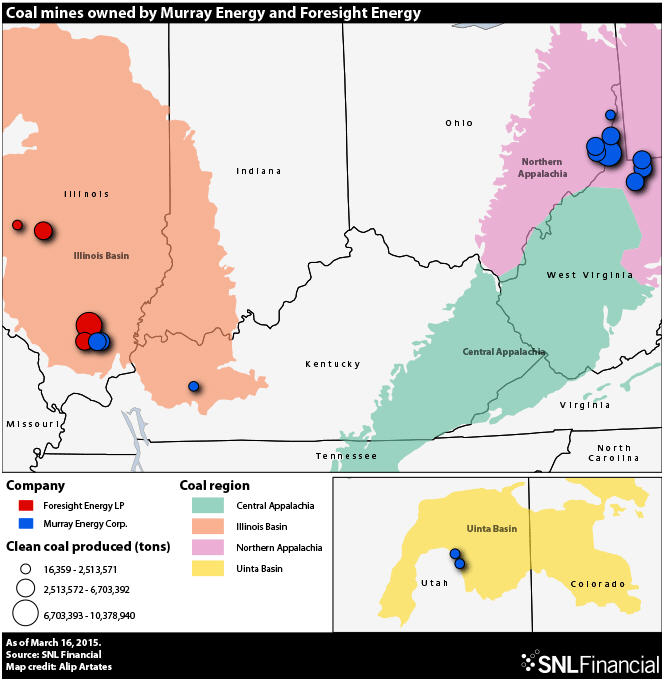Foresight deal would land Murray Energy at top of US coal’s two hottest basins
Murray Energy Corp., already a dominating force in the Northern Appalachia basin, plans to expand its footprint in the U.S. coal sector’s other geographical hot spot with a major $1.40 billion investment in Illinois Basin-producer Foresight Energy LP.
In late 2013, Murray closed a deal in which it acquired five longwall coal operations from CONSOL Energy Inc., a move that positioned Murray as a top producer in the Northern Appalachia coal basin. In the most recent quarter, seven of Murray’s mines were among the top 12 producing in the region.
According to SNL Energy data, the Foresight acquisition would push Murray to the rank of top producer in both the Illinois Basin and Northern Appalachia. The combined production of Murray and Foresight bumps Murray from the fifth-largest coal company in the U.S. by tons produced to fourth, jumping over Alpha Natural Resources Inc. and falling just behind Cloud Peak Energy Inc. based on 2014 production.
 According to an SNL Energy analysis of U.S. Mine Safety and Health Administration data, Foresight produced about 22.78 million tons of coal in 2014 and Murray produced about 13.75 million tons from the Illinois Basin. The combined Illinois Basin production of Murray and Foresight, about 36.53 million tons in 2014, represented about 26.6% of all coal produced from the region in that year.
According to an SNL Energy analysis of U.S. Mine Safety and Health Administration data, Foresight produced about 22.78 million tons of coal in 2014 and Murray produced about 13.75 million tons from the Illinois Basin. The combined Illinois Basin production of Murray and Foresight, about 36.53 million tons in 2014, represented about 26.6% of all coal produced from the region in that year.
Murray hopes to close the transaction in the second quarter of 2015, according to company spokesman Gary Broadbent. Following the close, Murray will remain a privately held company and Foresight will remain publicly traded, he said, adding that it was possible certain Murray assets could be “dropped into” the Foresight master limited partnership structure in the future.According to an SNL Energy analysis of U.S. Mine Safety and Health Administration data, Foresight produced about 22.78 million tons of coal in 2014 and Murray produced about 13.75 million tons from the Illinois Basin. The combined Illinois Basin production of Murray and Foresight, about 36.53 million tons in 2014, represented about 26.6% of all coal produced from the region in that year.
Murray also had recently expanded its reserve base in the Illinois Basin with a seconddeal with CONSOL that included about 100 million tons of coal reserves and resources in Illinois. According to Murray’s March 15 news release, the $1.40 billion cash deal has created a U.S.-based coal miner with more than 9 billion tons of coal reserves.
Philip Gonet, president of the Illinois Coal Association, said that both operators have a good record in terms of safety and production and believes that the companies will do well.
“They’re both good operators,” said Philip Gonet, president of the Illinois Coal Association. “With Murray’s expertise being in longwall, to go along with what seems to be Foresight’s strength in the new longwalls — that seems to be a synergy that makes sense.”
Already a significant production force in the Illinois Basin with the New Era and New Future mines, Murray’s acquisition of a controlling interest in Foresight Energy LP and Foresight Energy GP LLC will enlarge its footprint even further. The deal is expected to create a dominant, low-cost U.S. coal producer.
Murray produced a total of about 62.81 million tons of coal in 2014, including 46.21 million tons from its coal operations in Northern Appalachia. Combining Murray’s and Foresight’s total 2014 production results in about 85.59 million tons, about 8.6% of the 997.1 million tons of U.S. coal production in 2014.
Murray told SNL Energy in January that it planned to boost production at its own mines slightly in 2015, despite an expectation that coal markets will continue to be depressed through the rest of the year.
According to SNL Energy data, Murray is a major supplier to several large utilities including FirstEnergy Corp., American Electric Power Co. Inc., Southern Co.,PPL Corp. and NRG Energy Inc. Some of the top power plants served by Murray are in states such as Pennsylvania, West Virginia, Illinois, Ohio, Georgia and Kentucky.
Both Illinois and Northern Appalachia have been the beneficiaries of a decline in production from Central Appalachia. While the coal market as a whole has languished, many producers in the two regions have been able to maintain a relatively high level of success through the downturn.
Murray’s strategy to pump up investment in U.S. coal comes at a time when many of the major coal players are looking at other opportunities. CONSOL has shifted to natural gas, noting the assets it sold to Murray did not fit CONSOL’s growth strategy. Foresight Energy founder Chris Cline has set his sights on Canada and Australia and recently told SNL Energy he is looking for opportunities to expand there. The deal announcement said Cline is to remain a significant investor in Foresight.
“In this extremely distressed coal marketplace, a coal mining company must strive to be the lowest cost producer in any sourcing region,” said Robert Murray, chairman, president and CEO of Murray in a recent press release. “Foresight Energy has continued to be the low cost producer in the Illinois Basin, with a focus on safely producing high quality, high heat coal, strategically located near low cost transportation. This is wholly consistent with the ‘Concentric Ellipse’ strategy that I outlined for Murray Energy nearly thirty years ago.”
Murray described his strategy of choosing coal assets based on concentric circles drawn out from every power plant in the country at a 2014 industry conference. He began using concentric circles to find out where high-heat coal was nearest to plants where sulfur dioxide controls were and expanded those into concentric ellipses to account for where truck or water transportation was available. After identifying where high-heat coal was located near the power plants that would need it, he would acquire those assets.
Foresight coal mines among most productive in US
The latest acquisition now gives Murray controlling interest over some of the most envied, low-cost coal mines in the country. Speaking on a recent earnings call, Foresight President and CEO Michael Beyer said that according to MSHA data, the company’s three longwall complexes were the most productive underground mines in the country based on clean tons produced per man hour worked.
“This high productivity helped us to maintain our industry leading low cost position with average operating costs of $20.80 per ton for the full year,” Beyer said.
In contrast, Arch Coal Inc. reported an average total operating cost per ton of $77.59 in its Appalachia segment. Looking to both domestic and international markets, Beyer said Foresight is optimistic about its low-cost structure and during the fourth quarter and successfully added over 4.3 million tons of new business for delivery in 2015 through 2019.
“With our low-cost structure and transportation options, we feel we are well positioned to navigate our way through any market condition. In a low price market environment like we have today, we can adjust our production schedules, lower pace of growth and produce less than our productive capacity,” Beyer said. “In a higher priced market, we have plenty of production capacity available to continue on the growth trajectory of the past few years.”In contrast, Arch Coal Inc. reported an average total operating cost per ton of $77.59 in its Appalachia segment. Looking to both domestic and international markets, Beyer said Foresight is optimistic about its low-cost structure and during the fourth quarter and successfully added over 4.3 million tons of new business for delivery in 2015 through 2019.
At a recent industry conference, Emily Medine, a principal with Energy Ventures Analysis Inc., said that though it has its challenges, the Illinois Basin is one of the few bright spots in the coal industry. The low-cost region is relatively undeveloped compared to the exhausted seams in Appalachia and with the recent close of Patriot Coal Corp.‘s Highland mine, there are no longer any union mines in the Illinois Basin.
“The Illinois Basin is going to be the basis of survival for the eastern U.S. coal industry as we go forward,” Medine said at Platts’ 23rd Annual Coal Properties and Investment Conference.
Medine noted that competition from the Northern Appalachia basin is one of the greatest challenges to Illinois Basin producers.
The acquisition, however, may also include some risk. Foresight’s top-producing coal mine, the MC No. 1, is currently qualified for pattern of violations, or POV, status criteria by MSHA. While the mine has not been subjected to the increased and stringent enforcement of a POV notice, it could potentially be selected if MSHA initiates a screening process. Beyer told SNL Energy that the company is working with MSHA to avoid POV status.
Murray is looking to secure $2.46 billion in financing to help pay for the transaction.
{{ commodity.name }}
{{ post.title }}
{{ post.date }}





Comments